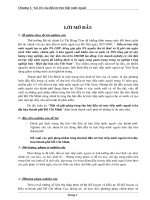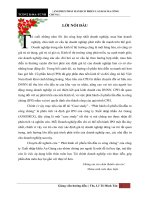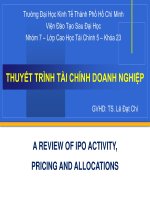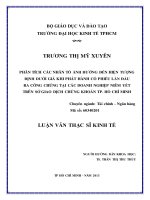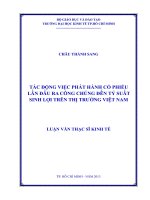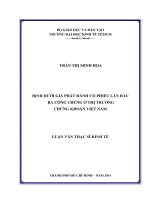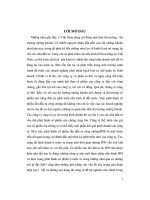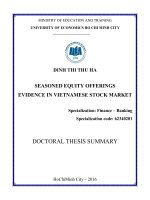Phát hành cổ phiếu bổ sung (seos) – bằng chứng tại thị trường chứng khoán việt nam. seasoned equity offerings (seos) evidence in vietnamese stock market
Bạn đang xem bản rút gọn của tài liệu. Xem và tải ngay bản đầy đủ của tài liệu tại đây (1.25 MB, 183 trang )
MINISTRY OF EDUCATION AND TRAINING
UNIVERSITY OF ECONOMICS HO CHI MINH CITY
DINH THI THU HA
SEASONED EQUITY OFFERINGS
EVIDENCE IN VIETNAMESE STOCK MARKET
DOCTORAL THESIS
HoChiMinh City – 2016
MINISTRY OF EDUCATION AND TRAINING
UNIVERSITY OF ECONOMICS HO CHI MINH CITY
DINH THI THU HA
SEASONED EQUITY OFFERINGS
EVIDENCE IN VIETNAMESE STOCK MARKET
Specialization: Finance – Banking
Specialization code: 62340201
DOCTORAL THESIS
SUPERVISOR:
Asso.Prof. HO VIET TIEN
Asso.Prof. BUI KIM YEN
HoChiMinh City – 2016
i
TABLE OF CONTENTS
List of Abbreviations
List of Tables
List of Figures
Chapter 1: Introduction ............................................................................... 1
1.1 Research motivation ............................................................................ 1
1.2 Research objectives ............................................................................. 6
1.3 Research questions .............................................................................. 7
1.4 Research scope.................................................................................... 8
1.5 Research methods ............................................................................... 8
1.6 Research contributions ........................................................................ 10
1.7 Structure of the study .......................................................................... 11
1.8 A summarize of thesis findings ........................................................... 13
Chapter 2: Literature review and Hypotheses development....................... 16
2.1 Introduction .......................................................................................... 16
2.2 Theoretical literature on SEOs .............................................................. 16
2.2.1 Trade-off Theory ...................................................................... 16
2.2.2 Growth Opportunities Theory ................................................... 18
2.2.3 Market timing theory ................................................................ 20
2.2.4 Agency problem theory ............................................................ 23
2.2.5 Efficient Market Hypothesis ..................................................... 24
.................................................................................................
2.3 Literature review on SEOs empirical studies ........................................ 27
2.3.1 Determinants of company’s SEOs motivation .......................... 27
2.3.1.1 Trade-off theory................................................................ 27
2.3.1.2 Growth Opportunities Theory ........................................... 28
2.3.1.3 Market timing theory ........................................................ 30
ii
2.3.1.4 Agency problem theory .................................................... 32
2.3.2 Market’s reactions to company’s SEOs .................................... 33
2.3.2.1 Growth Opportunities Theory ........................................... 33
2.3.2.2 Market timing theory ........................................................ 35
2.3.2.3 Efficiency market hypothesis ............................................ 37
2.4 Hypotheses building and variable measurements ................................. 40
2.4.1 Determinants of company’s SEOs motivation .......................... 40
2.4.2 Market’s reaction to company’s SEOs ...................................... 43
2.5 Conclusion .......................................................................................... 45
Chapter 3: Data and methodology ............................................................... 47
3.1 Data ................................................................................................... 47
3.2 Methodology ..................................................................................... 51
3.2.1 Determinants of company’s SEOs motivation .......................... 51
3.2.2 Market reaction to company’s SEOs......................................... 56
3.2.2.1
Event study .................................................................. 56
3.2.2.2
Determinants of market reaction to company’s SEOs ... 64
Chapter 4 Determinants of company’s SEOs motivation............................ 71
4.1 Statistics summary ............................................................................. 71
4.1.1 Distribution of SEOs over the sample period (2007-2013)........ 71
4.1.2 SEOs probability description .................................................... 73
4.2 Determinants of company’s SEOs motivation .................................... 79
4.3 Determinants of company’s SEOs motivation by issuance method .... 85
4.4 Conclusion ......................................................................................... 91
Chapter 5 Market’s reaction to company’s SEOs ....................................... 92
5.1 Data description ................................................................................... 92
5.2 Market reaction to company’s SEOs ..................................................... 93
5.2.1 Market reaction around announcement day ................................ 93
iii
5.2.2 Market reaction around ex-right day .......................................... 102
5.3 The relation between announcement day and ex-right day .................. 111
5.4 Determinants of market reaction to company’s SEOs .......................... 112
5.4.1 Determinants of market reaction around announcement day ...... 112
5.4.2 Determinants of market reaction around ex-right day .............. 117
5.5 Conclusion .......................................................................................... 122
Chapter 6 Conclusion and Suggestion......................................................... 124
6.1 Conclusion .......................................................................................... 124
6.2 Suggestion for stakeholders................................................................ 126
List of publications
References
Appendices
iv
LIST OF ABBREVIATIONS
AAR: Average abnormal returns
AD: Announcement day
AR: Abnormal returns
CAR: Cumulative average abnormal returns
EMH: Efficient market hypothesis
HOSE: Ho Chi Minh City Stock Exchange
SEOs: Seasoned equity offerings
XR: Ex-right day
REC: Real estate and construction
MAI: Manufacturing industry
SER: Service
FBI: Financial – Banking – Insurance services
AFF: Agriculture, Fishery and Forestry
LIST OF TABLES
Table 1.1: Vietnamese lending interest rate ....................................................... 4
Table 3.1: VNIndex and Market capitalization of listed domestic companies (% of
GDP) in 2006 -2013 ......................................................................................... 50
Table 3.2 Classification criteria: ........................................................................ 51
Table 3.3 SEOs-motivation independent variables description........................... 55
Table 3.4 SEOs-price reaction independent variables description ..................... 69
v
Table 4.1 Distribution of SEOs over the sample period (2007-2013) ................. 71
Table 4.2 SEOs probability data description ...................................................... 73
Table 4.3 Characteristics between SEOs companies and non-SEOs companies . 75
Table 4.4 SEOs description by issuance method ................................................ 78
Table 4.5 SEOs conducting probability ............................................................. 83
Table 4.6 Average marginal effects on SEOs probability ................................... 84
Table 4.7 SEOs by equity right and by equity bonuses or dividends probability 88
Table 4.8 Average marginal effects on SEOs equity right and by equity bonuses
or dividends probability ..................................................................................... 90
Table 5.1 Characteristics of SEOs companies around event day data description
.......................................................................................................................... 92
Table 5.2 AAR and CAR around announcement day ......................................... 95
Table 5.3 AAR and CAR around announcement day in favorable and unfavorable
market timing .................................................................................................... 97
Table 5.4 Market reaction around announcement day divided by criteria ......... 100
Table 5.5 AAR and CAR around ex-right day ................................................. 103
Table 5.6 AAR and CAR around XR day in favorable and unfavorable market
timing .............................................................................................................. 106
Table 5.7 Market reaction around announcement day by criteria ..................... 109
Table 5.8 Determinants of market reaction around SEO announcement day .... 116
Table 5.9 Determinants of market reaction around SEOs ex-right day ............. 121
vi
LIST OF FIGURES
Figure 1.1: Listing value and Market capitalization ........................................... 4
Figure 1.2: Research methods ............................................................................ 9
Figure 2.1: Conceptual framework .................................................................... 39
Figure 5.1 Relation between AD and XR ......................................................... 111
1
CHAPTER 1
INTRODUCTION
1.1 Research motivation:
Seasoned equity offerings (SEOs) draw enormous attention from researchers
around the world. This method is an effective and popular way to expand
company financial resources to maintain and develop its activities, to reconstruct
capital and stakeholder structure of company. In order to finance companies’
activities, they can choose either internal sources or external sources of funding.
While the former mainly refer to profit or retained earnings, the latter mention the
concept of debt financing as well as equity financing. To estimate company’s
financing decisions Modigliani and Miller (1958, 1963) suggest that capital
structure is not consistent with firm value. Nevertheless, this observation is based
on the important assumption that the market is perfect. The idea of perfect capital
market consists of the following characteristics: (i) companies are classified based
on their risk; additionally, companies having the same risk generate similar
returns; (ii) perfect capital market which implies that there is no transaction cost,
also no tax or bankruptcy cost; (iii) the interest rate for lending and borrowing
activities are similar for private and investors as well as corporation. However, in
the real market, tax is deducted from interest expenditure. Nevertheless, debt
financing pressure may discourage firms to entirely use debt financing instead of
equity financing (Huang, 2012). Besides the trade-off theory which mainly
discuss tax shield as well as financial distress, there are also other factors affect
the financing decision of company including information asymmetry costs,
agency conflict costs and the availability of promising growth opportunities
Besides, a trend of increasing international equity issuance has also been
reported, especially after the financial crisis in 2010. To compensate for the losses
2
and larger writedowns suffering from the crisis as well as to raise capital in the
prediction of more strict regulations will occur, global financial institutions have
to raise equity issuance substantially. A report of Bloomberg in July 2010 shown
that financial institutions, mainly from Europe and the United States, since mid2007 had raised US$1.5 trillion equity issue to offset their crisis losses (Witmer,
2010).
The paucity of literature and case study in emerging market where results are
inclusive also urge a solution. There have been many research to find out
company and market behavior such as determinants of companies that lead them
to conduct SEOs, impact of SEOs on company stock prices when information
about SEOs are publicized. The number of research on this topic has been
increasing with many aspects have been discovered and applied in practice.
However, the majority of existing SEOs research are examined at developed
market (Eckbo et. al., 2007) while only few research on cases of emerging market
are conducted. The paucity of literature and case study in emerging market has
drawn attentions from researchers to this market. Therefore, examining emerging
economy case attracts the interest to fill the research gap and emphasize the own
nature of this market. In additional, examining whether the results of developed
markets can be carried over to emerging market also becomes appealing. In
addition to examining determinants of company’s SEOs decision, researchers also
show that stock prices on the market will be affected when information about the
issuance is publicized. In contrast to negative reactions in developed markets, the
results of emerging markets are inclusive. While there is a trend of positive
reaction in the research of Kim and Lee (1990) for Korea; Salamudin et. al.
(1999) for Malaysia; Tan et. al. (2002) for Singapore; Marisetty et. al.
(2008) for Indian, the findings of Cahit (2006) for Turkey; Chen et. al. (2007)
and Shahid (2010) for China; and Lerskullawat (2011) for Thailand, on the other
3
hand show negative reaction.
The development and new trend in financing resources of Vietnamese Stock
market also become a driving force. Since its first establishment with only two
listed companies in 2000, Vietnamese stock market has witnessed remarkable
development, the number of listed companies has strongly increased in both listed
value and market capitalization (Figure 1.1). Besides, Vietnamese stock market
gradually becomes more attractive to foreign investors. International integration
helps raise the position, foster Vietnamese stock market to a higher level among
international financial market (e.g. in 2013, the HOSE became official member of
the World Federation of Exchanges), enhance the value of listed companies,
attract more foreign investment, and achieve more opportunities so that it can
access to international standards, exchange and absorb the experience of
developed markets. With that impressive development, Vietnamese stock market,
however, is still a very young market with the history of only over 15 years since
its establishment. Vietnamese companies are still in favor of traditional finance
such as loans borrow from banks. However, high lending interest rate (table 1.1)
accompanied by the financial crisis in 2010 had strongly affect the banking
system, firms were not confident in the possibility of providing loans from banks,
and in return, bank themselves had no belief in firm’s ability to pay the loan since
both sides were impacted due to the crisis. Consequently, when bank financing
can not play its traditional roles, companies turn their attentions to equity
financing.
4
Figure 1.1: Listing value and Market capitalization
(Source: hsx.vn)
Table 1.1: Vietnamese lending interest rate
Year
Lending interest rate (%)
2006
11.18
2007
11.18
2008
15.78
2009
10.07
2010
13.14
2011
16.95
2012
13.47
2013
10.37
(Source: theglobaleconomy.com)
5
In addition, SEOs gradually become more appealing to Vietnamese companies.
From 2007 to 2013, there were 482 cases that companies use SEOs to pay
bonuses or dividends, or to increase their financial resources by issuing equity
rights offerings. This fact has shown that SEOs is a popular method for
companies to manage their financial and investment activities, gradually become
more widespread and of interest in Vietnam. Furthermore, SEOs on Vietnamese
stock market also draw attention from researchers e.g. Nguyen Quang Diep
(2011) examines capability of Vietnamese investors in evaluating long-run
operating performance of the issuers. Vo Xuan Vinh and Doan Minh Thai (2015)
investigate market reaction to company stock price and trading volume when
information about cash dividend is publicized. Vo Xuan Vinh and Phan Thi Anh
Thu (2015) examine market reaction to information about companies’ stock split.
Vo Xuan Vinh and Dang Buu Kiem (2015) investigate trading of foreign
investors when information about cash dividend is announced. Recently, Vo
Xuan Vinh and Dang Buu Kiem (2016) examine the stock market reaction
measured by abnormal trading volume around ex-dividend day using data set of
listed firms on HOSE. However, there is lack of study investigating thoroughly
behavior of listed companies in regarding of why Vietnamese companies conduct
SEOs and market reaction around event day when information about SEOs by
dividend or rights are publicized. Therefore, limited number of SEOs literature in
the context of Vietnam should be increased to fill this empirical gap.
The important function of SEOs in the Vietnamese capital market and in case of
SEOs companies, accompanied by the role of enhancing knowledge of investors
about behavior of SEOs companies and behavior of the market have led us to this
comprehensive research. Base on the findings, we then point out relevant
suggestions for related stakeholders such as SEOs companies and investors.
6
In case of investors: should investors join or leave companies that
intend to issue SEOs. Are there any signs to recognize the issuance
in order to prepare necessary financial resources in case investors
want to join the issuance? What are relevant investment strategies
toward equity of company conducting SEOs in order to earn
money?
In case of SEOs companies: what methods could be applied to
increase the effectiveness of the issuance in terms of maximizing
proceeds collected from the issuance and increasing company value
by conducting SEOs.
1.2 Research objectives
Vietnam is in the CIVETS group include Colombia, Indonesia, Vietnam, Egypt,
Turkey, and South Africa which can be represented for new stardom candidates
among emerging markets. Although these six CIVETS countries still suffer from
some disparities during their development, they do have common element for
emerging market such as young populations, stable politics, domestic economic
structure diversification, less commodity exports reliance, relatively developed
financial markets, outperforming returns potential (Korkmaz et. al., 2012).
The main objectives of this thesis are to investigate thoroughly SEOs in the
context of emerging market with Vietnamese stock market case. This objective
serves to fill the gap of literature lacking in this region. Besides, it is among the
first study in Vietnam to focus on many aspects of SEOs in terms of
determinants of company’s SEOs motivation, market reaction and determinants
of market reaction to company’s SEOs.
7
We examine SEOs in Vietnam on two aspects:
Company’s SEOs motivation by examining why do Vietnamese
companies conduct SEOs.
Market reaction to company’s SEOs by examining how does
market react to company’s SEOs, which express through the
fluctuations of stock prices. Subsequently, we develop the
estimation model to measure to what extend the theories mentioned
in previous SEO studies can be applied to explain market reaction
to companies SEOs in case of Vietnam stock market.
Furthermore, we then compare our findings with existing literatures.
1.3
Research questions
Objective 1: Examining company’s SEOs motivation
Why do Vietnamese companies conduct SEOs?
Objective 2: Examining market reaction to company’s SEOs
How does market react to company’s SEOs?
Does
classifying
companies
into
three
criteria:
Market
capitalization, Industry and Issuance method make any differences
in terms of market reaction?
To what extend the theories mentioned in previous SEO studies can
be applied to explain market reaction to companies SEOs in case of
Vietnam stock market?
8
1.4 Research scope
This research covers only companies listed on the HOSE during 2007 – 2013.
Stock prices are collected from HOSE website. The data is collected from
financial statements of HOSE listed companies which are extracted from the
database of Orbis.
Research sample comprises companies conducting their SEOs as right
distributions; or rights accompanied with dividends; or rights accompanied with
bonuses; and companies issued their SEOs as bonus or dividend payments.
The event days include announcement day and ex-right day which are widely
publicized on the media.
SEOs companies are classified according to three criteria (market capitalization,
issuance method and industry).
1.5 Research methods:
To examine the company’s SEOs motivation, we apply logit/probit model to find
the determinants of company motivation to issue SEOs. Based on the interpreted
results, we will suggest relevant recommendation for investors and SEOs
companies.
To examine the market reaction to company’s SEOs, we first apply the Event
study method developed by Campbell, Lo and MacKinlay (1997) to study the
market reaction around event day, then using random effects and fixed effects
model on panel data to investigate determinants of market reaction around event
day. Based on Hausman test, we select the appropriate model and interpret
results in according to relevant financial theories then point out relevant
suggestions for stakeholders.
9
RESEARCH METHODS
Company’s SEOs motivation
Why do Vietnamese companies
conduct SEOs?
Quantitative method
Market reaction to company’s
SEOs
How does market react to
company’s SEOs.
The extent of SEO theories
application into Vietnamese stock
market
Quantitative method
Logit/probit model on STATA
Event study method.
Random effects/Fixed effects
models for panel data on STATA.
Results interpretations.
Results interpretations.
Conclusion and relevant policy suggestions.
Figure 1.2: Research methods
10
1.6 Research contributions:
Contribution to SEOs literature:
Our research covers different aspects from previous research regarding SEOs
area. Firstly, we investigate SEOs using data from Vietnamese market which has
not been examined yet. We refer to SEOs literature in both developed and other
emerging markets to form the research hypotheses then examine whether the
results of those markets can be carried over to Vietnam.
Conducting research on SEOs is mainly based on Event study; its objective is to
measure the financial assets value fluctuation, which is resulted from particular
event. The number of research applying this method is approximate 565 topics
from 1974 to 2000 in top five journals of business and finance (Khotari and
Warner, 2006), however the number of studies on SEOs in developing countries
is relatively limited. In addition to the out-of-sample tests, this research also fills
the gap and enriches the literature on cases of emerging market where the results
are inclusive and very limited, from then to draw an overall picture in
comparison to developed markets, which have been wildly discovered; therefore
the research findings enrich existing literature related to SEOs in Vietnamese
market, especially to discover how much Vietnamese stock market can catch up
with mature market. This research also examines Vietnamese stock market
characteristics, Vietnamese investors and SEOs companies on many aspects:
SEOs motivations and market reaction.
Contribution to empirical study:
Raising capital through conducting SEOs brings certain benefits to issuing
companies in comparison to debt borrowing or cash dividends. However, there
are very few research about this topic be conducted at Vietnamese stock
exchange, Vietnamese listed companies, therefore lack of necessary references.
11
With this research, we fill the gap about SEOs research and contribute an
empirical study since it enrich existing literature of SEOs in Vietnam. Investors,
SEOs companies can use this research as a reference material in their trading,
investment and management activities toward information management, making
trading decisions. Investors could consider trading stocks of SEOs companies to
earn profits, reserve money in advance to “catch the issuance”, or to have
relevant actions toward these kind of SEOs.
SEOs is also considered a way to test the efficiency level of the market.
Furthermore, the level of efficiency of market can be reflected through the
transparency of information, which is one of the most crucial elements that
market legislators should ensure to the investors, especially the minor ones.
Market legislators can consider using this research as a way to test the level of
information transparency in the market to take relevant actions toward the
current market situation.
Applying a well-known Event study method to investigate how does market
react to different issuing method such as to increase company capital by equity
rights or to pay bonuses/dividends, we compare stock price reaction to those two
methods to provide more evidence in the field of SEOs in Vietnam, which can be
used as reference or studying material for students.
1.7 Structure of the study:
The remaining of the research is organized as follows: Chapter 2 presents the
literature concerned SEOs in most relevant study. We review thoroughly how
SEOs research have been examined in both developed as well as emerging
market. For an easily approach we then build a conceptual framework to
summarize financial theories that have been previously applied. At the end of
12
this chapter, based on the existing SEOs literature in both developed and other
emerging markets we develop hypotheses for our study. We also include in this
chapter three appendices to summarize tables of our literature surveys.
In Chapter 3: Data and Methodology, we present the way our data is collected,
along with the criteria to classify them. Besides, we describe methodology is
applied in our study with proxies for the relevant theories, estimation regression
models, along with the detail description of Event study method, which help in
our empirical estimation in chapter 4 and chapter 5.
Chapter 4: Determinants of company’s SEOs motivation is the first empirical
result chapter regarding to companies motivations that lead them to conduct
SEOs. We examine the determinants in four areas: trade-off, growth
opportunities, market timing and agency problem theory, those theories have
strong impact on company’s SEOs decisions. In this chapter, the logit/probit
model is applied to identify determinants of company’s SEOs motivation. We
then compare our results to existing previous study to draw a comprehensive
picture on Vietnamese case.
Chapter 5 examines market reaction to SEOs in two categories: (1) how the
stock prices fluctuate around announcement day and the ex-right day; (2) the
determinants of stock price reactions. We apply the standard Event study method
to measure the stock price reaction while regression models on panel data (Fixed
effect and Random effect models) are chosen to examine determinants of market
reaction to company’s SEOs. In this chapter, we focus on the differences of
stock price reactions after classifying the data into three criteria: market
capitalization, industry and issuance method, we especially focus on the type of
issuance method on whether companies issue SEOs to raise capital by equity
13
rights or to pay dividends/bonuses due to our expectation that different purposes
of issuance will lead to remarkable differences in the way the market react.
In chapter Conclusion and Suggestion, we summarize our findings and point out
relevant suggestions for related stakeholders.
1.8 A summary of thesis findings:
We present main results in two aspects: SEO motivations and market reaction to
company’s SEOs.
In conclusion, regarding the motivations of company’s SEOs, it is found that two
over four seminal theories are supported: (i) in term of trade-off theory, we find
that companies with lower leverage ratio in comparison to average of industry’s
leverage ratio are more likely to use SEOs to adjust their capital structure. This
result is irrelevant to the trade-off theory since we expect companies with higher
leverage ratio in comparison to average of industry’s leverage ratio have more
possibility to use SEOs to reduce leverage; however in case of Vietnamese
companies, this result might be explained that companies with lower ratio of
leverage relative to industry’s average leverage will also have tendency to issue
SEOs in order to fill the gap in capital shortage of company. (2) Regarding the
growth opportunities theory, our results suggest that companies tend to issue
SEOs when they have more growth opportunities, which is consistent with the
growth opportunity theory. (3) Regarding the market timing theory, we find that
companies experience higher ratio of market value/book value tend to conduct
SEOs more. We believe this supports the market timing theory that predicts
companies will choose the time when market overvalues their stocks to issue
seasoned equity. (4) Regarding agency problem theory, we find no evidence to
support decision that SEOs is motivated as a tool to conduct advantage over
14
minority shareholders by controlling shareholders, which is inconsistent with the
agency problem theory. Besides the main theories, we also find that smaller
companies, companies with higher ratio of total debts/total assets, companies
with higher profitability are more likely to conduct SEOs.
Examine on market behavior, our results show that Ho Chi Minh stock market is
not efficient in term of semi-strong form. Before the announcement day, there is
a trend of stock purchasing, which is a sign of information leakage
Around announcement day, price increase significantly in both period before and
after that day. On contrary, in case of ex-right day, after this day, the increasing
trend will not prolong.
Before event day, market tends to favor companies conduct SEOs by equity
bonuses or dividends than by equity rights. However, investors will soon adjust
their behavior by selling those stocks which already generated high profit.
In examining the determinants of market reaction to company’s SEOs around
announcement day, our results show that (1) There are no evidences to support
the influences of growth opportunities on market reaction around announcement
day. However, in case of Vietnamese stock market, this result can be explained
that investor might not see information about growth opportunities advantageous
information when consider buying SEOs, or they are not fully aware of the
availability of company growth opportunities. (2) Regarding to market timing
theory, we find that the condition of the market before announcement day
influences the market reaction. Investors will base on the condition of the market
from 2 to 3 months before announcement day to make their decisions on whether
to get involved in company SEOs. This result supports market timing theory
influence on determinants of market reaction to company’s SEOs. Besides, our
15
result shows that equity rights generated less returns than the method of equity
bonuses or dividends.
Regarding the determinants of market reaction to company’s SEOs, (1) TobinQ
which is proxy for growth opportunities is significant with positive signs,
suggesting that the information about existence of company growth opportunities
influence the reaction of the market. We conclude that the growth opportunities
theory impact on market reaction around ex-right day. (2) The market timing
theory, on the other hand show no significant result, implying that market
condition before ex-right day does not influence the reaction of the market.
Besides, we find positive relation between issue size and market reaction. This
might be explained that in case of Vietnamese stock exchange, the larger the
issuance, the higher that market liquidity, which leads to positive reaction of the
market. Firm size shows negative relation to market reaction around ex-right
day. We think that, in case of Vietnamese stock market, investors might believe
that the larger the company is, the more complicated it is, therefore the capital
generated from the issuance may not be used effectively.
16
CHAPTER 2
LITERATURE REVIEW AND HYPOTHESES DEVELOPMENT
2.1 Introduction
SEOs play significant role on company capital structure as well as stakeholder
structure. This chapter present different studies about SEOs in both developed as
well as emerging markets. Theoretical investigations cover main theories
regarding SEOs including Trade-off; Agency problem; Growth opportunities;
and Market timing. The evidences of these studies are mostly similar in both
developed and emerging economies. The organization of this section is as
followed:
The main purpose of section 2.2 is to review financial theories regarding SEOs,
while in section 2.3 the findings of previous research in terms of determinants of
company’s SEOs motivation, market reaction as well as determinants of market
reaction to company’s SEOs that have been used in previous SEOs research will
be reviewed; from then the conceptual framework will be built up to form an
overall picture. In section 2.4, we build the research hypotheses and variables
measurements while Section 2.5 is the conclusion of this chapter.
2.2 Theoretical literature on SEOs
2.2.1 Trade-off theory
Study of financial structure has been dominated the research area of corporate
finance. Since Modigliani and Miller (1958) first introduce their research on
financial structure in the context of capital costs, corporate finance and
investment theory, it has drawn enormous attention from researchers to the
discussion about the applicability of financial structure theory into reality. The
17
research of Modigliani and Miller has set the very first step of financial theory
development in terms of compromising tax system and bankruptcy costs
considering then the existence of an optimal ratio of debt suggesting (Ghazouani,
2013)
Trade-off theory is one of the financial theories that have significant impact on
company capital structure in the context of corporate and personal taxes effects,
bankruptcy costs, etc. According to trade-off theory, company will try to aim at a
target debt level to form an optimal capital structure then gradually move
towards it. This theory suggests that managers need to make right decision on
building financial structure to keep balance as well as optimize the equity and
liability in the company. The optimal debt-equity structure in a company can be
determined by trading off the costs and benefits of financing through debt and
equity. According the trade-off theory, company conducts SEOs to optimize
capital structure to balance the benefit and expense that might be generated from
debt borrowing (Modigliani and Miller, 1958, 1963; Myers, 1977). This will lead
to the existence of a target leverage that maximizes the value of the firm,
requiring that any deviation from that target leverage should be adjusted.
Trade-off theory has been testified by some empirical research as one of the
theories affect company’s SEOs decisions (Marsh, 1982; Hovakimian et. al.,
2001; Bo et. al., 2011). Hovakimian et. al., (2001) show that when companies
adjust their capital structure, they tend to move toward a target debt ratio that is
consistent with theories based on tradeoffs between the costs and benefits of debt.
On the other hand, Bo et. al. (2011) investigate the relevance of traditional
theories Chinese SEOs motivation. With the case of 1081 Chinese SEOs during
1994–2008, the authors find that the trade-off theory is consistent to Chinese
listed companies who strongly depend on loan borrowings from the banking

